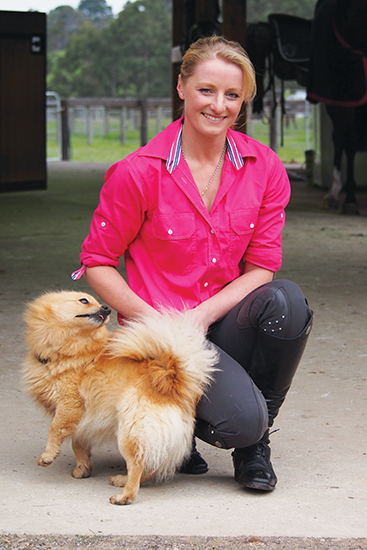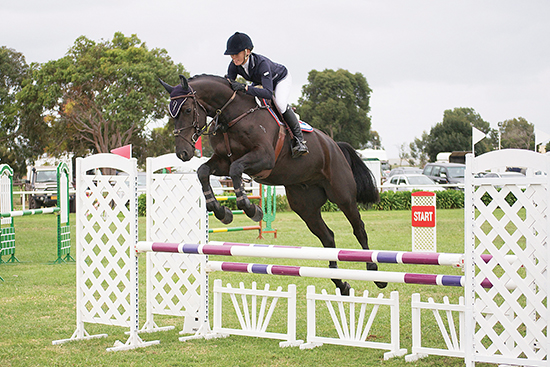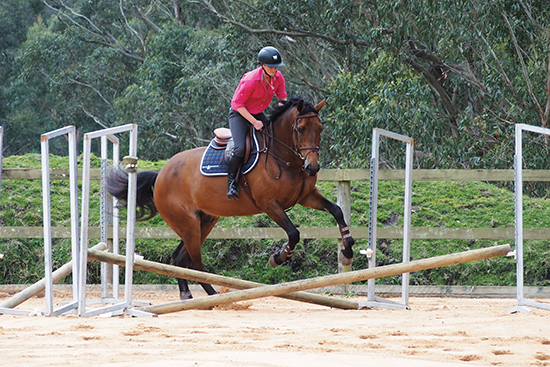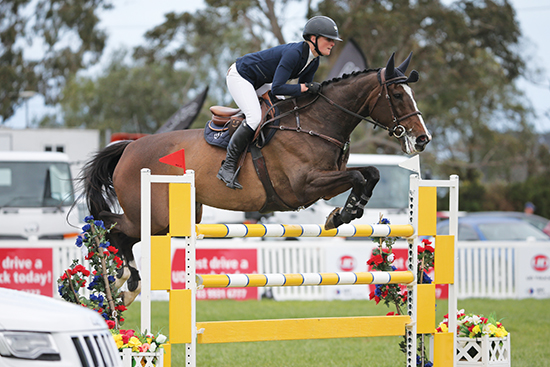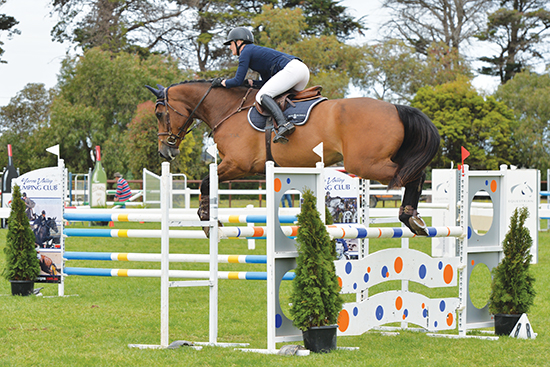Words and photos by Ute Raabe, roz neave and derek o’leary
As I drive down a beautiful tree-lined road in Garfield North, I am thinking that this is horse heaven; lush green paddocks are stretching to the left and the right, filled with horses grazing contently. At the end of the road I turn into an idyllic little yard with a barn and two cottages, Hylton Park. A kelpie, a heeler and a fluffy Pomeranian run over to greet me followed by a bubbly blonde with a big smile on her face, Alex Rooney.
Alex had just returned from the Adelaide Royal show and is getting her team of horses ready for her next event, the Australian Showjumping Championships at Werribee. Hylton Park is home to Alex, her boyfriend Jack Erickson, her parents, and it is also the name of Alex’s showjumping business.
Alex rode for Rod Brown in New South Wales for over a year and was motivated to venture out on her own, “I thought I’d come home and give it a go, but it’s a hard gig, and the outlay costs are quite high.”
Alex also rides work for several racing trainers three mornings a week, teaches at adult riding clubs and coaches some junior and young riders. She loves working with the next generation, “It is nice to see them succeed, there is so much progression at that age. I get quite a buzz out of it.”
When did you start riding yourself?
“Goodness me, that’s my mother’s fault. Mum taught herself how to ride out of a book. She always wanted a horse when she was a kid and never had a chance. Dad bought her first horse for her and she broke it in herself – from reading the book! It’s lucky she didn’t die… [Laughs] Then she had my brother and me and didn’t have any horses for a while. One day she caught me pulling all the Hoofs & Horns magazines and THM off the shelves and she couldn’t get me away from them, so she thought she better get me a horse!”
“I went to pony club and tried everything, dressage, show ring, games, eventing… but when I was about 16 I really liked showjumping and got stuck into it from then. I really like the type of horse, showjumping horses think for themselves a little more, not just about the rider. You want them 40% thinking about you and 60% focusing on the fence and what is going on. I really like that they use their own brain.”
What was your first good horse?
“My mare, Calypso. I haven’t had any superstars yet; she is my best horse so far. I worked with her all on my own; she’s a one-girl type of horse. Or let’s put it this way, she was pretty horrendous to begin with and no one wanted to ride her, but we got there in the end.”
Who is helping you now?
“I get a bit of help of Jamie Coman. I have been really lucky in the last few years, I have had help from many good riders, Rod Brown, George Sanna, Billy Raymont – I have been able to mix it with some seriously good horsemen and riders. I learned a lot by just listening to people and working at their places and asking questions at shows, for example when walking the track at a show. It’s a wonderful community, most showjumpers are very supportive of the younger people coming up through the ranks.”
How often do you work with Jamie?
“On and off, but mainly during the show run. It is really good to have eyes on the ground. My boyfriend Jack and I help each other as well, we work well together. There’s a little bit of rivalry when are competing in the same event, but that’s okay, it’s healthy.”
“I am spending so much time with great trainers here, who in turn have been to Europe, that I am able to steal all their information and experience. My main priority is setting up my business here and making it successful. Going to Europe is not always the be-all and end-all; there are amazing trainers here too. I’d rather help to improve the sport here. If everyone keeps going to Europe and leaving us, we can’t do it.”
Are there any European riders that you look to for inspiration?
“Katharina Offel and Penelope Leprevost would be my favourite female riders. Penelope is an amazing rider; she has a beautiful seat and position. And Katharina, she gets the job done.”
Alex’s current competition horses are a real mix, with one off-the-track Thoroughbred and two Warmblood horses, one 17 hands and one 15 hands, the latter with a dressage pedigree!
Calypso is Alex’s Grand Prix horse is an eleven-year-old Thoroughbred mare: “Calypso was bought as a five-year-old off-the-track for $500. She was hard work as she is very very hot and hard to train. She was too nutty for the track; she ran her race before the race. But she has come around very nicely now; she is very scopey and very careful for a Thoroughbred. She is an awesome horse, she would do anything for you now.”
“We were going along great guns until a few years ago when we were in a really bad truck accident. She got injured quite badly and probably was unlikely to ever be ridden again. She was at the vet clinic for six weeks, flesh wounds and broken bones, and had 12 months off with just box rest and lots of treatment.”
“I trained her on the treadmill for a long time and took things very slowly. When I sat on her for the first time, she felt okay. Eventually I started riding her properly and jumping her again to test how she would cope. She went to Adelaide Royal last year and came fourth in the World Cup. I was so stoked that I got my horse back!”
“Then she got kicked – she fractured her splint bone and damaged her cannon bone badly. She was out until three or four months ago. Adelaide this year was her first show after the broken leg. So that’s her story, she’s had a pretty rough trip…”
Alex and Tulara Balouch, Champion of Champions at DJWTS in 2011
On to the Warmbloods…
“Tulara Chico is my young horse, he won the Five-Year-Old class at Jumping with the Stars earlier this year. I bought him as a yearling after I rode Tulara Balouch who won Champion of Champions in 2011. I thought to myself ‘oh I want another one!’ I was lucky, I sold a nice little horse to a Junior and I was able to buy Chico from Tulara Stud. He has turned out to be pretty special and is very trainable.”
“I broke Chico in myself and trained him from scratch. He taught me a lot about Warmbloods, I mainly worked with Thoroughbreds before. As a four-year-old Chico was really slow and dopey, he moved well but he was slow in the brain. As soon as he turned five, it was like something clicked. He turned into a horse.”
“For the next 12 months I want to keep him at 1.15m/1.20, get him really confident at that. Being such a big horse I haven’t put a lot of pressure on him yet. I have just given him spurts of work and then long spells. His knees have closed up now and he is a lot stronger, he can deal with a big show now.”
“After the Australian Champs Chico will do a couple of little shows, back down to 1.10 metres. When you step a horse up, you always have to step them back down again to keep their confidence He’s still a little immature mentally. But most importantly I don’t expect too much of him yet. I will concentrate on educating him for the future. He has definitely got scope enough to be a Grand Prix horse. I am very excited about him.”
Chico working at home on the sand arena
Alex also has young mare, bred by Bloomfield Farm.
“This one is Bloomfield Royal Nazika, by Royal Hit, and I just started her in the last few months. She’s bred for dressage, but she is a real jumper. She has got a big stride and is very scopey. I just jump her at a metre now, I hope to have her at D grade for the Victorian season.”
“I don’t go to every show and say, right, I am going to win this class. Some events you have to take as match practice. You need to have a yearly plan and decide which show is the one you are aiming to win at, and then develop a program leading up to that show. You also have to pick a particular class; say that’s the class you’re going to ride the jump-off in. You need to use the smaller height classes for training and teaching the horse.”
“With Calypso, I will increase her work coming to the shows. However, with her injuries I have to be very careful bringing her back into work, it is a fine balance. So she will do a lot of treadmill work for about three weeks at the start. Because she injured her wither I need to strengthen her back muscles without riding her. If I put the saddle on at the start of the preparation she would be sore.”
At the Australian Championships, Alex decided to ride Calypso in the Mini Prix instead of the Senior Event. She felt that her horse was not yet ready for the big class after having had only one start prior to the event. They finished seventh overall.
“Then I change it a bit: I take her to the beach for a swim, I do a lot of road work, I trot up the road and there’s a hill. I found the road work to be really good, because if you hit some hard ground at a show, their legs cope better than if you were working in the arena all the time. We have a gravel road and native bushland.“
“There are still all the other things that you want to work on in the arena, I start introducing some jumping – little grids and bounces – and get their muscle memory back. As it gets closer to the show I give the Thoroughbred mare a couple of good hit outs. I also up the ante on the flatwork and keep the workload at this level while the shows are on.”
“With the Warmblood, Tulara Chico, I do my fitness work early on and as the shows come I drop off the work load a bit. I want him fresh and happy, with a lot of energy left in the tank and interest in the jumping. Chico does road work as well because Warmbloods are a lot harder to get fit. With Thoroughbreds you have to work with their brain a lot more, they are naturally fitter. With Warmbloods you have to work on their fitness AND keep them interested. I won’t jump him much between shows, perhaps once a week. I mainly do road and flat work and perhaps include some bounces or pole work. After a show he gets walked for a couple of days and also on the day before a show.”
Tulara Chico jumping in the Emerald Series. No ribbon this time, but Alex was happy with her horse: “He jumped well, just made some green, baby mistakes and got distracted.”
“The most important thing with these horses, because they work so hard and you expect so much of them, is to have a really good relationship with your farrier and your vet. Most people forget how physically demanding this sport is. You need to be able to communicate with your farrier and feel if something is not quite right.”
“I always do a blood test and a thorough vet assessment before I bring the horses into work for the season. I want to start on a clean slate. Good maintenance is most important, that includes icing the horses’ legs after heavy work, feeding joint supplements and regular physio work. I use a physio about once a month, but I massage my horses a lot myself. Because I look after my horses myself, I know what their legs look like and how they should walk out of their stable. I assess and adjust their rations every couple of days depending on the work they have done, and how they feel.”
Alex is a rider who has tasted the heartbreaks of the sport… let the good times rip…
Alex would like to thank her sponsors Troy Laboratories and HorsePower.
This article first appeared in the December 2014 issue of THM.

